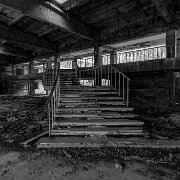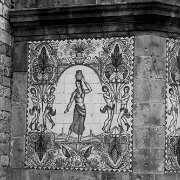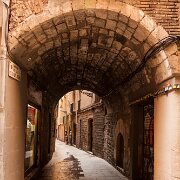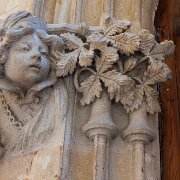
12 Lee Plaza (Also known as the Lee Plaza Hotel or Lee Plaza Apartments) is a vacant high-rise apartment building in Detroit, Michigan... The building was designed by Charles Noble and constructed in 1929, it rises to 15 floors and is an excellent example of Art Deco architecture of the 1920s.
First built as an ornate high rise hotel along West Grand Boulevard, Lee Plaza was an upscale apartment with hotel services. Decorated with sculpture and tile outside, the structure rivaled the Book-Cadillac Hotel and Statler Hotel for architectural notice in Detroit during the 1920s. After economic contraction, the apartment's ownership changed several times, being used as a Senior Citizen's complex before finally closing as a residence in the early 1990s. During its years of vacancy, much of the artwork, internal wiring, fixtures and valuable material has been removed illegally by scavengers.
First built as an ornate high rise hotel along West Grand Boulevard, Lee Plaza was an upscale apartment with hotel services. Decorated with sculpture and tile outside, the structure rivaled the Book-Cadillac Hotel and Statler Hotel for architectural notice in Detroit during the 1920s. After economic contraction, the apartment's ownership changed several times, being used as a Senior Citizen's complex before finally closing as a residence in the early 1990s. During its years of vacancy, much of the artwork, internal wiring, fixtures and valuable material has been removed illegally by scavengers.

13 The University of Oxford (informally Oxford University or simply Oxford) is a collegiate research university located in Oxford, England. While having no known date of foundation, there is evidence of teaching as far back as 1096, making it the oldest university in the English-speaking world, and the world's second-oldest surviving university. It grew rapidly from 1167 when Henry II banned English students from attending the University of Paris. After disputes between students and Oxford townsfolk in 1209, some academics fled northeast to Cambridge, where they established what became the University of Cambridge. The two "ancient universities" are frequently jointly referred to as "Oxbridge".

14 The University of Oxford (informally Oxford University or simply Oxford) is a collegiate research university located in Oxford, England. While having no known date of foundation, there is evidence of teaching as far back as 1096, making it the oldest university in the English-speaking world, and the world's second-oldest surviving university. It grew rapidly from 1167 when Henry II banned English students from attending the University of Paris. After disputes between students and Oxford townsfolk in 1209, some academics fled northeast to Cambridge, where they established what became the University of Cambridge. The two "ancient universities" are frequently jointly referred to as "Oxbridge".

15 The Mississippi State Capitol stands as an impressive testament to the state's rich history and architectural grandeur. Construction of the Capitol building began in 1901 and was completed in 1903. Designed by architect Theodore C. Link, the Capitol showcases a stunning Beaux-Arts architectural style, characterized by its symmetrical layout, grand dome, and intricate ornamentation. The exterior is adorned with Corinthian columns, detailed friezes, and sculptures, while the interior boasts exquisite marble and mosaic work, elegant chandeliers, and a majestic rotunda. The Capitol building is situated on a prominent hill in downtown Jackson, commanding a commanding presence and offering panoramic views of the city. It serves as the seat of the state's legislative branch and remains an iconic symbol of Mississippi's political history.
The Mississippi State Capitol has witnessed many significant historical events throughout its existence. It has been the site of important legislative decisions, political debates, and ceremonial occasions. Over the years, the building has undergone renovations and expansions to accommodate the growing needs of the state government while preserving its architectural integrity. The Capitol also serves as a repository of Mississippi's history, housing notable artifacts and artwork that showcase the state's heritage.
The Mississippi State Capitol has witnessed many significant historical events throughout its existence. It has been the site of important legislative decisions, political debates, and ceremonial occasions. Over the years, the building has undergone renovations and expansions to accommodate the growing needs of the state government while preserving its architectural integrity. The Capitol also serves as a repository of Mississippi's history, housing notable artifacts and artwork that showcase the state's heritage.

16 The Michigan State Capitol, located in the heart of Lansing, stands as a testament to the state's rich history and democratic principles. Designed by renowned architect Elijah E. Myers and completed in 1879, the Capitol's majestic neoclassical architecture exudes a sense of grandeur and civic pride. Its distinctive dome, rising 267 feet above ground level, serves as a prominent focal point, adorned with a stunning cupola and topped by a bronze statue of "Justice" symbolizing the state's commitment to fairness and equality. The Capitol's exterior, constructed primarily of sandstone, features elaborate Corinthian columns, intricate carvings, and ornate details that showcase the craftsmanship of its era.
Steeped in political significance, the Michigan State Capitol has witnessed key moments in the state's legislative history. It served as the meeting place for the Michigan Legislature and housed the state's executive offices, providing a forum for debate, lawmaking, and governance. Throughout its storied past, the Capitol has undergone several renovations and expansions to accommodate the evolving needs of Michigan's government while preserving its architectural integrity.
Steeped in political significance, the Michigan State Capitol has witnessed key moments in the state's legislative history. It served as the meeting place for the Michigan Legislature and housed the state's executive offices, providing a forum for debate, lawmaking, and governance. Throughout its storied past, the Capitol has undergone several renovations and expansions to accommodate the evolving needs of Michigan's government while preserving its architectural integrity.

17 Iași City Hall, housed in the historic Roznovanu Palace, stands as a testament to the city's rich political and architectural heritage. Originally constructed in the late 18th century, the palace underwent significant reconstruction between 1830 and 1833 under the direction of Iordache Ruset-Roznovanu, a member of the influential Rosetti family citeturn0search1. Designed by architect Gustav Freywald, who also contributed to the Iași Metropolitan Cathedral, the palace initially showcased Neoclassical architectural elements citeturn0search4. Throughout its history, the building has played pivotal roles, notably serving as the seat of the Romanian government during World War I
Architecturally, Roznovanu Palace reflects a blend of Neoclassical design with later influences, embodying the evolving aesthetic sensibilities of Iași over the centuries. Its façade and interior details highlight the grandeur typical of noble residences of its era. Today, while functioning as the administrative center for the city's governance, the palace also serves as a cultural landmark, hosting various events and exhibitions that celebrate Iași's historical and artistic legacy citeturn0search0. Situated on Bulevardul Ștefan cel Mare și Sfânt, the building remains a focal point for both locals and visitors, symbolizing the enduring spirit of Iași's past and present
Architecturally, Roznovanu Palace reflects a blend of Neoclassical design with later influences, embodying the evolving aesthetic sensibilities of Iași over the centuries. Its façade and interior details highlight the grandeur typical of noble residences of its era. Today, while functioning as the administrative center for the city's governance, the palace also serves as a cultural landmark, hosting various events and exhibitions that celebrate Iași's historical and artistic legacy citeturn0search0. Situated on Bulevardul Ștefan cel Mare și Sfânt, the building remains a focal point for both locals and visitors, symbolizing the enduring spirit of Iași's past and present

18 The I.A. Gagarin Youth Centre in Chișinău, Moldova, was inaugurated in 1972 as a prominent hub for youth and cultural activities during the Soviet era. Funded through weekend labour initiatives by Komsomol members—the youth division of the Communist Party—the centre featured an 800-seat auditorium, a 400-seat theatre, sports facilities, a disco, and a hotel designated for foreign guests. Notably, it hosted workshops, including one where the Soviet Union's first energy-saving lamp was reportedly developed. The building's façade is adorned with the striking "Plowman of the Universe" mosaic by artist Aurel David, exemplifying socialist modernist art. Following the Soviet Union's dissolution in the early 1990s, the centre fell into disuse and now stands as one of Moldova's most significant abandoned structures, with plans for its demolition to make way for residential development

19 The I.A. Gagarin Youth Centre in Chișinău, Moldova, was inaugurated in 1972 as a prominent hub for youth and cultural activities during the Soviet era. Funded through weekend labour initiatives by Komsomol members—the youth division of the Communist Party—the centre featured an 800-seat auditorium, a 400-seat theatre, sports facilities, a disco, and a hotel designated for foreign guests. Notably, it hosted workshops, including one where the Soviet Union's first energy-saving lamp was reportedly developed. The building's façade is adorned with the striking "Plowman of the Universe" mosaic by artist Aurel David, exemplifying socialist modernist art. Following the Soviet Union's dissolution in the early 1990s, the centre fell into disuse and now stands as one of Moldova's most significant abandoned structures, with plans for its demolition to make way for residential development

20 The Jewish Funeral Hall in Chișinău, Moldova, stands as a poignant remnant of the city's once-thriving Jewish community. Constructed in the early 20th century, the hall was part of the larger Chișinău Jewish cemetery complex and served as a sacred space where families could perform traditional rites and rituals before burial. The building is notable for its Neo-Moorish architectural style, a design choice reflecting the cultural richness of the Jewish diaspora in Eastern Europe. The funeral hall bore witness to both the flourishing of Jewish life and the tragedies that befell the community, including the devastating pogroms of 1903 and 1905. During the Soviet era, the cemetery and its buildings suffered from neglect, and many structures were damaged or destroyed. Today, the funeral hall, though in a fragile state, is recognized for its historical and cultural significance, representing both the memory of the Jewish community in Chișinău and the broader narrative of Jewish history in Moldova.











Buildings, Details